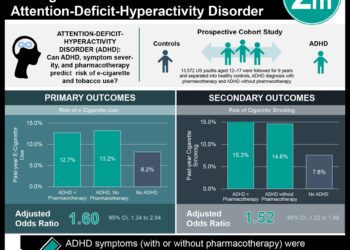2 Minute Medicine Rewind November 6, 2023
1. This randomized clinical trial showed that very low birth weight (VLBW) infants who received extrauterine placental perfusion (EPP) had similar postnatal hematocrit levels compared to those who received delayed cord clamping (DCC)
2. The EPP group demonstrated significantly higher postnatal peripheral and cerebral oxygenation.
Evidence Rating Level: 1 (Excellent)
DCC for at least 30 seconds in preterm infants improves survival and reduces complications. These benefits may be attributed to adequate lung aeration before cord clamping, also known as physiological-based cord clamping. Current recommendations do not consider VLBW infants who might lack sufficient lung aeration prior to clamping. An alternative approach involves cesarean-born infants with the placenta still attached and subsequent respiratory support, termed EPP. The EXPLAIN trial aims to evaluate the efficacy of EPP compared with DCC. The trial enrolled and randomized 60 infants with a gestational age greater than 23 weeks and birth weight less than 1500g born by cesarean delivery in a 1:1 ratio to receive EPP (intervention) and DCC (control). The primary outcome—mean (SD) hematocrit levels 24 hours after birth—was comparable between the EPP and DCC groups, with 56.0% (1.8%) and 53.9% (1.8%), respectively. Compared to infants in the control group, those in the EPP group exhibited significantly higher peripheral oxygen saturation (adjusted mean difference at 5 minutes, 15.3% [95% CI, 2.0% to 28.6%]; P=0.04) and regional cerebral oxygen saturation (adjusted MD at 5 minutes, 11.3% [95% CI, 2.0% to 20.6%]; P=0.01). There were no significant differences in other predefined neonatal outcome parameters, but there was a significantly higher mean maternal blood loss during cesarean delivery in the intervention group (P=0.05). This increase is not considered clinically significant by obstetricians. Overall, the findings of the first trial of EPP suggest that while EPP showed comparable postnatal hematocrit levels to DCC, peripheral and cerebral oxygenation during the transition period were significantly higher. Larger trials are required to fully assess EPP’s impact on neonatal outcomes.
1. This randomized placebo-controlled clinical trial found that the daily use of Streptococcus salivarius K12 probiotics did not decrease the incidence of acute otitis media among children attending day care.
Evidence Rating Level: 1 (Excellent)
AOM is a prevalent infection in children and a major contributor to antibiotic use in children. With the need for novel prevention strategies, this double-blind, randomized, placebo-controlled trial conducted across 50 day care centers in Finland assessed the efficacy of S. salivarius K12 probiotics in preventing AOM among children attending day care. 827 children (mean [SD] age, 4.1 [1.6] years; 47.6% girls) were enrolled and randomized in a 1:1 ratio to receive either the S salivarius K12 probiotic or a placebo for six months. The primary outcome assessed was the incidence of AOM requiring antimicrobial therapy, with 8.2% (34 children) in the probiotic group and 5.8% (24 children) in the placebo group experiencing at least one episode, resulting in a non-significant relative risk of 1.42 ([95% CI, 0.86-2.34]; proportion difference, −2.44% [95% CI −5.94% to 1.09%]; P=.17). The mean time to the first AOM episode did not differ significantly between groups, with 174 days in the S. salivarius group and 176 days in the placebo group (P=.18). Recurrent otitis media (≥3 AOM episodes in 6 months) was also similar between the probiotic (1.0%) and placebo (0.5%) groups (proportion difference, −0.50% [95% CI, −1.81% to 0.84%]; P=.41). Overall, these findings indicate that S. salivarius K12 does not confer a reduction in AOM incidence and highlight the need for continued research into effective AOM primary prevention strategies.
1. This phase 3 randomised trial demonstrated that compared with placebo in combination with trastuzumab and docetaxal, pyrotinib in the same combination conferred significantly improved progression-free survival in patients with human epidermal growth factor receptor 2 (HER2) positive metastatic breast cancer.
Evidence Rating Level:1 (Excellent)
HER-2 breast cancer makes up approximately 20% of all breast cancers. Pyrotinib is a small molecule, irreversible, pan-HER receptor tyrosine kinase inhibitor that targets epidermal growth factor receptor and HER2, as well as HER4. This randomized, double-blind, multicentre, phase 3 trial involving 590 patients with HER2-positive metastatic breast cancer, aims to evaluate the efficacy of pyrotinib compared with placebo, both in combination with trastuzumab and docetaxel. Patients were randomly assigned in a 1:1 ratio to the pyrotinib group (median age [IQR] 52 [46-58] years) and placebo group (median age [IQR] 52 [46-57] years), comprising 297 and 293 patients, respectively. Pyrotinib, trastuzumab, and docetaxel, significantly improved progression-free survival compared with the placebo in the same combination (24.3 [95% CI 19.1 to 33.0] months versus 10.4 [9.3 to 12.3] months; hazard ratio 0.41 [0.32 to 0.53]; one sided P<0.001). These findings were consistent in subgroup analysis, including in those with and without previous (neo)adjuvant trastuzumab and varying treatment-free intervals. Objective responses were significantly higher in the pyrotinib group, with 83% (95% CI, 78% to 87%) achieving a response compared to 71% (65% to 76%) in the placebo group (difference 12.2%, [5.4% to 18.9%]; one-sided P<0.001). Patients receiving pyrotinib experienced higher rates of grade 3 or above treatment-related adverse events (90% vs. 76% in the placebo group), but no treatment-related deaths occurred. Overall, these findings demonstrate a statistically significant improvement in progression-free survival with pyrotinib in combination with trastuzumab and docetaxel compared with placebo, with a manageable safety profile. This treatment regimen could constitute a novel first-line therapy for patients with HER2-positive metastatic breast cancer.
1. Total knee arthroplasty was found to decrease the incidence of depression among patients to 85% at 6 months follow-up.
2. Higher pre-operative Beck’s Depression Scale scores corresponded to worse knee function scores post-operatively.
Evidence Rating Level: 2 (Good)
Knee surgical procedures in relation to osteoarthritis are increasingly common due to rising life expectancy, but they entail complications, leading to higher financial burdens, reduced recovery time, and lower quality of life. Depression, with an estimated prevalence of 29.9% has negative postoperative outcomes after knee surgery. This cross-sectional study recruited 150 patients undergoing primary total knee arthroplasty to explore the occurrence of depression symptoms in this population and assess how pre-operative depressive symptoms independently predict various health-related quality of life measurements. Pre-operatively, 99.3% of the recruited subjects were classified as moderate to severely depressed according to the Beck’s Depression Scale. At 3 months postoperative, 76% (n=114) demonstrated mild depression and 24% (36) were considered border-line depression. At the 6-month follow-up period, 85% (128) of patients were classified as normal, while 15% experienced mild depression. Post-surgery, a significant improvement was observed in knee function scores namely the Knee Society Score (KSS) function scale (P < 0.001) and Western Ontario and McMaster Universities Arthritis Index (WOMAC) scale (P < 0.001). Regression analysis indicated that increased time elapsed since the procedure (P<0.001), higher Beck’s Depression Scale scores, and lower (worse) baseline KSS physical functioning scores corresponded to higher (worse) WOMAC scores. Overall, these findings suggest a bidirectional relationship between mental health and surgical outcomes—surgery confers significant improvements in mental health status, whereas worse pre-operative mental health status predicts poorer surgical outcomes.
1. This cross-sectional study found that physical activity, employment, pain, and sense of control were the most important factors that influenced health-related quality of life in middle-aged men and women.
Evidence Rating Level: 2 (Good)
HRQoL, a crucial metric in public health research, encompasses both physical and mental aspects of health and is influenced by a complex interplay of factors such as age, sex, socioeconomic status, and physical and mental well-being. This multicenter, cross-sectional study of 29,212 individuals aged 50-64 from the general population in Sweden (mean [SD] age 57.5 [4.3] years; 48% men; mean physical HRQoL score 52.4 [9.0]; mean mental HRQoL score 37.2 [5.2]), investigated the factors most important for physical and mental HRQoL using the Short Form 12 questionnaire. The study utilized machine learning to evaluate the association of 356 variables, including demographics, lifestyle, symptoms, physiological measurements, and health conditions, each assigned an importance score reflecting its impact on HRQoL. Men and women had comparable scores for physical HRQoL (men: 53.4 [SD 8.1], women: 51.4 [SD 9.7]) and mental HRQoL (men: 37.1 [SD 5.0], women: 37.3 [SD 5.4]). Key factors affecting physical HRQoL were physical activity (with an importance score of 40), employment (36), pain (33), sleep (33), sense of control (26), breathlessness (18), body size (14), and allergy (10). The order of importance remained consistent between genders except for pain, which ranked higher for women. Key factors for mental HRQoL included sense of control (18), physical activity (12), depression (12), pain (6), employment (5), age (5), sleep (4), and alcohol (3). Men ranked physical activity, employment, and sleep, higher than women, while women ranked depression, pain, body size, and family health history higher. Overall, these findings highlight that men and women shared similar HRQoL levels, with physical activity, employment status, pain experience, and sense of control influencing physical and mental HRQoL the most. These factors are modifiable and should be the target of future public health interventions.
Image: PD
©2023 2 Minute Medicine, Inc. All rights reserved. No works may be reproduced without expressed written consent from 2 Minute Medicine, Inc. Inquire about licensing here. No article should be construed as medical advice and is not intended as such by the authors or by 2 Minute Medicine, Inc.







